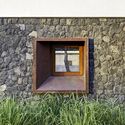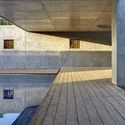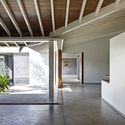
-
Architects: RMA Architects
- Area: 7000 m²
- Year: 2014
-
Photographs:Tina Nandi, Rajesh Vora, Rahul Mehrotra
-
Manufacturers: AFFA Tile
-
Lead Architects: Rahul Mehrotra, Robert Stephens
-
Consultants: Vijay K. Patil & Associates, Arkk Consultants

Text description provided by the architects. The Three Court House is conceived as a series of similar but varied modules that could be constructed incrementally. The use of discrete modules allows the form of the house to conform to, and take advantage of, the unique shape of the site. By restricting the height to one floor, the house is able to blend in with its humble surroundings. The incremental nature of the plan breaks down the scale and mass of the house to relate to the adjacent village. This is contrary to most weekend homes in the area that consolidate space in a large 'villa-like' form. The approach of disaggregating form is a model that could be used for middle class families whose economic condition forces incremental investments in their homes. A small outbuilding at the entry of the site, constructed with the same formal and material palette as the house, contains a clinic - as the owner of the home is a well-known medical practitioner. Adjacent to the clinic are staff residences, and together these two programs create a social interface and soft threshold with the village.












.jpg?1550583688)













